|
|
||
.jpg) |
|
.jpg) |
|
|
||
|
VIII. TRAINS & ROADS IN BULGARIA |
||
|
|
||
|
|
||
.jpg) |
|
.jpg) |
|
|
||
|
VIII. TRAINS & ROADS IN BULGARIA |
||
|
|
||
|
1. The trains in BG
. - main rail station - all the trains stop there; the map is not so correct - there are much more station all the trains are stopping. Due to many reasons Bulgarian trains are not fast averaging no more than 30 - 36 miles per hour, but using the train when touring increases possibilities for bicyclists. I use trains very often while I am touring. The ticket prices are relatively low. For example (March 2025) the price of the ticket Sofia - Varna is 15/20 EURO for IInd and Ist class respectively; Sofia - Burgas - 12/16 EURO. Coaches Ist and IInd class are available (Ist class coach/cart is labelled by "A"), buying tickets you have to point which class you prefer. There are several trains having only Ist class coaches. On the ticket for Ist class it will be signed the number of your coach & seat. The Ist class coaches have a yellow strip out just below the cart roof, I think it is an international sign. An additional very small (1/2 EURO) charge is necessary to book a seat number on your ticket for the IInd class. My suggestion is to have seat number for longer destinations and especially Friday and Sunday afternoons - usually these days more people are travelling by trains. Coaches with beds are available too. It is possible to book train tickets a month before your travelling, usually in the day of travelling tickets for such wagons are not available. Important for bicyclists: For your bicycle you have to buy an additional ticket - 1,5 EURO/bicycle, never mind of destination and distance. Having such a ticket you will have not problems with the train staff. Smocking in BG trains is forbidden. Have in mind the trains do not drag a special baggage coach ! The next is the link for the train schedule in English: https://www.bdz.bg/en/ - a detail BG train schedule in English. |
||
| Some pictures & suggestions | ||
 |
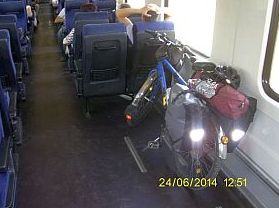 |
A. Trains having coaches for unable people Such coaches are labelled by "C". Look for the symbols I have surrounded in red on the photo. In such coaches there is enough place for several bikes, no problem to load several bikes in it. |
 |
 |
B. Wagons which doors are at both sides of the coach. (On the coach label you can see its number, class and destination.)
Always use the last door of the last coach !!! There is enough place for 2 (even 3) bicycles. Of first you have to remove panniers because wagon stairs are high, steep and narrow. Tight and lock (!) bicycles to the wall - bungee cords are very usable again. It would be better if change position of the hand bars, but it is not so necessary. Not nice is the situation, when you see already there are 2 bikes in this place, especially if it is not the initial train station. I can not give you an reasonable advice in such a case, maybe try the same in the first wagon - its first door, but it is usually used by the train chief ... never mind, it is an opportunity, I believe, the train chief will help you. |
 |
||
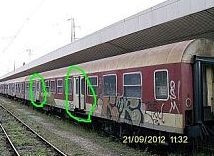 |
C. Wagons having 2 doors in the middle of them. Most of trains in BG are supplied with such coaches. Load your bicycles again in the last one. The doors are wide, here loading of the bicycles is easier comparing with the previous case. Again you have to remove all the baggage/panniers attached to the bicycles - it will make easier loading the bikes on the train. You can not leave bicycles next to doors, you have to behave depending of the wagon type - such wagons have 2 different interiors which can not be recognized looking at the coach outside. |
|
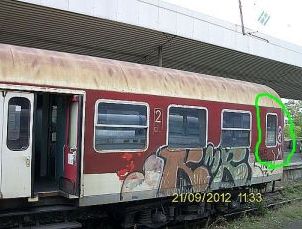 |
At both ends of the coach you can see 2 smaller windows. It is the place where there is a box parted from the coach saloon, usually there are not people there. If in this coach end is placed the toilet - there will be enough place for 2 bicycles. If there is not a toilet (it is in the other cart end) it is possible to load even 4 - 5 bicycles. The first coach of such a cart can be used for bicycles too. |
|
 |
So, taking on the train, you have to move towards the end box; there is enough place inside to move your bike between the seats. The same place can be used also in the coaches having the 3 folded seats in the saloon (next photos). A better case is, when entering in the wagon, next to its door you see a place with 3 folded seats. It is the best opportunity. Here there is enough place for 3 bicycles. In this case you can load your bicycles in each cart of the train. |
|
|
|
|
|
 |
 |
D. motor carriages In some destination in action are "Siemens" type motor carriage: electric - photo 1 (having 3 or 4 sections) or diesel - photo 2 (having only 2 sections). Both types are convenient to load bicycles on. |
|
|
To load your bikes use doors where you see a label for bikes. Often the bike symbol is erased, but nobody will stop you to load your bicycle. Next to this door is the toilet next to it there are several folded seats, where you can load 2 bicycles in the electric carriage and 3-4 in the diesel one respectively. Here is not necessary to remove panniers because the cart door is wide and its floor is not high.
Have in mind, that trains coming mornings in Sofia often are overcrowded, on contrary, evening trains leaving Sofia are the same. Also, Friday in the afternoon and Sunday in the afternoon trains leaving and coming in Sofia (as well as in bigger towns) are full of passengers. |
|
 |
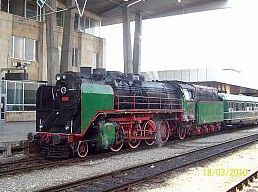 |
From time to time on the rails can be seen such old steam engines. Such retro trains are purposed for tourists. I have not seen such an engine at work since 1982. Now it is the "Orient express" as a tourist attraction.
PLEASE ASK ME IF THERE ARE SOME SPECIAL QUESTIONS FOR TRAINS !!! |
 |
||
|
F. The narrow-gage train Septemvri - Dobriniste In the end I can not miss to mention a special train traveling in Rodopi Mountain. As the traffic along the road N 84 (tpward Velingrad) is intensive, an appropriate way to enter in Rodopi Mountain is the narrow - gage train serving the line from Septemvri to Dobriniste. The red line on the map below shows places where the line is not next to the road.
More information concerning this amazing train can be seen here: http://en.wikipedia.org/wiki/Septemvri-Dobrinishte_narrow_gauge_line The narrow gage train can be taken on in Septemvri (at 8. 30 am), but my suggestion is to take it in Varvara (at 8.46 am). This place can also be used as an initial point to explore Rodopi mountains. There are several reason to use this amazing train when you begin exploring Rodopi mountains: - I think there are no many such trains in the world. Its velocity is 25 30 km/hours, the scenery of the area it is going is marvelous as it can be seen from the photos below; Each year I travel by it at least one time; - It is not a problem to load your bicycle in it (if bicyclists are more than 4 use different carts to load baggage (buy an additional ticket for the bike 1 EURO); - There is a traffic Varvara Velingrad and never mind it is not so intensive it would be better this road segment to be traveled by the train; - Some climbing can be avoided: altitude of Varvara is 270 m., Velingrad 750 m., the highest point Avramovo line station almost 1300 m. My suggestion to tourists having a restricted time for touring is to take on the train and enter in the mountain. It will save some time which can be used later to visit more exciting places in the mountain; - Depending of the route you have decided to do in Rodopi mountain, you can take off the train in Velingrad or Avramovo train station; - The train can be used also for a route in Rila Mountain (see the Chapter for routes in Rila mountain); - In the opposite direction it would be unnecessary to travel by the train. The pedaling down the mountain along the line is very pleasant. |
|
|
 |
|
| The Line Station in Varvara. The train from Varvara to Velingrad is here at 8. 46 am. | Inside the cart - no problem to load your bicycle in it. | The diesel engine - there are such engines made in Romania and former East Germany. At work since 1963. |
|
|
|
 |
| Avramovo Line Station. | ||
| Avramovo Line Station - the highest on Balkans - alt. 1267. | There are a lot of tunnels along the line. | Inside the engine - some time I arrange tourists to travel inside it. |
 |
 |
|
| The visibility in the engine is much better than in the cart, but it is not easy to arrange to travel in it. | ||
|
|
|
|
| In the mountain there are several serpentines of the line. | Velingrad Line Station. | |
|
|
|
|
|
|
|
 |
| Old steam engines can be seen in Bansko Line Station. | Rocks on the line after powering rain. Some time in the mountain it happens ... | |
 |
 |
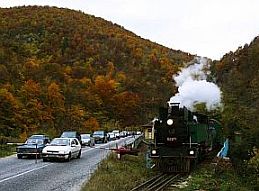 |
 |
 |
|
|
There is one original steam engine still at work, it is used only when there is a group of tourists paying in advance for such a travelling; See the video - speaking in Germans: https://www.youtube.com/watch?v=2JbJvinBQ8s https://www.youtube.com/watch?v=0N2FfKQjvtg |
||
|
2. Border Checkpoints
|
||
|
Border checkpoint in
red above MUST be avoided because of too
intensive traffic !!! 1. Points where Romania Bulgaria Border can be crossed (from west to east) are: |
||
|
Kalafat Vidin: bridge. Bechet Oryahovo: ferry. Turnu Magurele Nikopol: ferry. Zimnicea Svistov: ferry. Giurgiu Ruse: bridge. Oltenita - Tutrakan: ferry (still a project only). Calarashi Silistra: ferry. Constanta Silistra (Border Checkpoint Silistra). Negru Voda Kardam: Border Checkpoint Iovkovo. Mangalia Durankulak: Border Checkpoint Durankulak. |
There are two new open Border checkpoints, for which I do not know much: - Border Checkpoint Kaynardzha - Lipnitsa - open 2017 - Border Checkpoint Krushari - Dobromir - open 2018
For details look in chapter: III. Crossing Bulgaria from north (Romanian border) to south (Greece&Turkey borders), PART I: From Romania/BG Border to Balkan |
|
|
2. Points where Serbia
Bulgaria Border can be crossed Border Checkpoint Kalotina. Border Checkpoint Strezimirovctsi. Border Checkpoint Bregovo. Border Checkpoint Vrashka Chyka.
3. Points where Macedonia Bulgaria Border can be crossed Border Checkpoint Gyueshevo. Border Checkpoint Logodazh. From Border Checkpoint Zlatarevo - Novo Selo. |
|
4. Points where Bulgaria Greece border can be crossed (from west to east) are:
Border Checkpoint Kulata. Border Checkpoint Ilinden. Border Checkpoint Zlatograd. Border Checkpoint Makaza. Border Checkpoint Ivailovgrad Border Checkpoint Kapitan Petko Voivoda
5. Points where Bulgaria Turkey border can be crossed Border Checkpoint Kapitan Andreevo. Border Checkpoint Lesovo. Border Checkpoint Malko Tarnovo. |
|
3. Roads in BG |
||
|
As in my Home Page I have given a detailed information concerning roads in BG, here I will say only some very common information. Bulgaria has a well developed road system. Several years already the European Union supplies us with funds for road maintaining, renovation, reconstruction and building of new motor ways. |
As a whole our roads are in good conditions, the traffic on them is not heavy, excepting several main roads near bigger towns and resorts. When I plan a bike tour, I ALWAYS avoid roads of heavy traffic as much as it is possible. Last several years the traffic on more of the main roads is poor - it is better to avoid it as much as possible. |
|
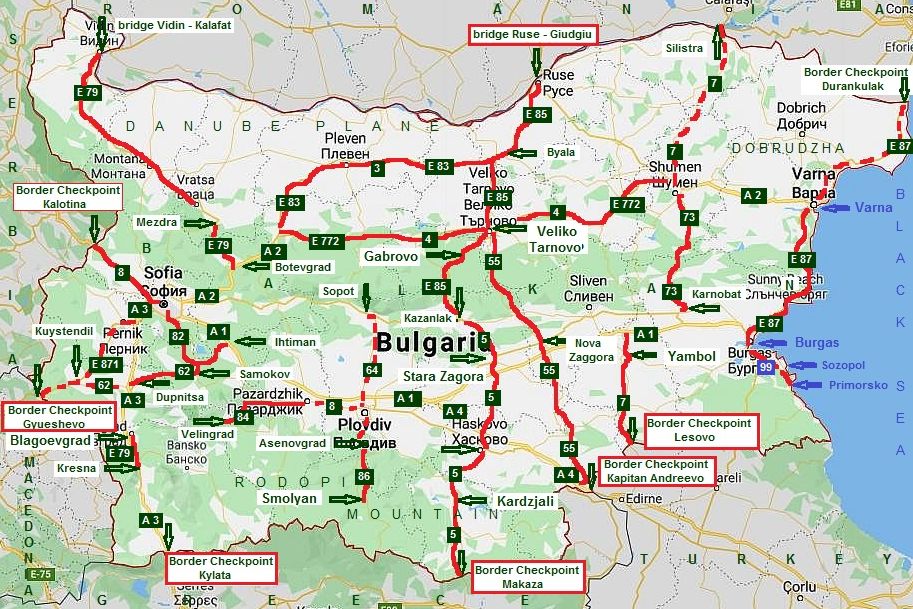 |
||
|
Needles to say that the motor roads are extremely dangerous and forbidden for pedaling: - Motor Road A1(Thrakia): From Sofia to Plovdiv to Burgas. - Motor Road A2 (Hemus): From Sofia to Varna (it is ready from Sofia to Yablanitsa and from Shumen to Varna. - Motor Road A3: From Sofia to Border Checkpoint Kulata (it is ready from Sofia to Blagoevgrad and from Kresna to Border Checkpoint Kulata) - Motor Road A4: connecting A 1 and Border Checkpoint Kapitan Andreevo.
My suggestion is to avoid the next roads: |
||
|
1. From Balchik to Varna to Burgas to Primorsko (E87 and 99). The traffic in the touristy season especially July and August is extremely terrible, there are many narrow segments. AVOID IT !!!! It is one of no many roads in BG signing "Bicycling forbidden"; In the Chapter IV. Bicycling along the sea side I have described haw in can be avoided to a big extend;
2. From Blagoevgrad to Kresna (E 79). One of the deadliest road segment in BG. In the Chapter III. Point 2 I have explained what to do just there;
3. E 79 From Botevgrad to Mezdra and from Vratsa to Montana to Vidin to Kalafat (in Romania). Except the road segment from Mezdra to Vratsa, where the road is save, all the others part of it is with a poor traffic and many heavy trucks;
4. From Veliko Tarnovo to Byala to Ruse (E85): One of the deadliest road segment in BG; there is an extremely intensive traffic;
5. Border Checkpoint Kapitan Andreevo to Nova Zagora to Gurkovo to Veliko Tarnovoto (road N 55). Terrible traffic including heavy trucks. Avoid this road !!!
6. Road N 7: From Border Checkpoint Lesovo to Yambol to A 1 and road N 73 from Karnobat to Shumen: again the traffic is intensive, it is better to avoid this road segments; and again road N7 from Shumen to Silistra - here the traffic is not so intensive;
7. Road N 8 from Sofia to Border Checkpoint Kalotina. avoid this road definitely. Soon there will be a motor road just there, so the use of Border checkpoint Kalotina will be absolutely unusable for bicyclists;
8. Road N 1 from Sofia to Vladaya to Pernik: very intensive traffic (no place to point this road on my map); |
9. From Border Checkpoint Gyueshevo to Kyustendil (E871) to Dupnica to Samokov (road 62) to Ihtiman (road (822) to Motor road A 1. Especially the road segment from Dupnitsa to Samokov is in a very poor condition with narrow segments, avoided it !
10. Road N 82 From Sofia to Samokov. Very scenic but very dangerous road; poor traffic especially weekends;
11. Road N 4 (E 772) it is the road segments connecting the ready parts of Motor Road N 2 from Sofia to Varna. This road MUST be avoided; there are 2 - 3 really deadly road segments.
12. Road N 86 from Plovdiv to Asenovgrad to Smolyan: very intensive traffic. The road from Plovdiv to Asenovgrad is after reconstruction, it is safe for pedaling.
13. Road N 85 from Veliko Tarnovo to Gabrovo to Kazanlak to Stara Zagora (Road N 5) to Haskovo to Kardzhali to Border Checkpoint Makaza. In the tourist season: July and August this road is used from Romanian tourists visiting Aegean; especially busy is the road segments from Veliko Tarnovo to Gabrovo and from Haskovo to Kardzhali to Border Checkpoint Makaza;
14. Road N3 (E 83) From A 2 to Pleven to Byala. Heavy traffic. There are very nice opportunities to pedal parallel to this road absolutely safe.
15. Road N 84 from Pazardzhik to Velingrad; Velingrad is a tourist place, the road is very busy especially weekends.
16. another roads not so pleasant for pedalling are near bigger cities, especially near Sofia and Plovdiv: - road N 8 from Pazardzhik to Plovdiv; - road N 64 from Plovdiv to Sopot; - road N 56 from Plovdiv to Rakovski; - road N 375 from Plovdiv to Pestera; - road N 19 from Blagoevgrad to Bansko. |
|
|
In my home page I have shown how to avoid this
dangerous roads in detail A little grumble now:
HOW
TO BEHAVE ON ROADS IN BG. |
||
|
You will be surprised, that drivers in BG usually are very patient and careful with bicyclists. They feel that bicyclists are exposed to dangers, and usually low the car velocity passing near them. Most of drivers will horn briefly seeing you, which here means "hello", some of them will salute you by hand, but please do not do the same, hold your hand bar tightly! |
So the only simple rule on the road is keep you close to the right white strip as you see on the photo. Please, follow this rule! Drivers (especially truck and buss drivers) will appreciate such a behavior very high. It is nice if the cycling group on the road is a compact one, I have noticed drivers are much more careful then. |
|
|
|
||
| DANGERS on the road | ||
|
The best situation on roads is if God is by our side, but it always would be nice to collaborate with Him as much as we can. My long year bicycling experience shows me, that if we have in mind several road features, our touring will be relatively save: - I hate it, but the helmet is really the most useful equipment for the bicyclist. Always use it! Glasses are very useful too; - NEVER bicycle in the dark part of the day, especially out of towns. I know that most of drivers have very poor eyesight in the darkness; - Bridges are places of a bigger danger. No possible to leave the road quickly if things are growing worse. Bicycle there as fast as possible, when you are assured there will be no cars on it. I always follow this my rule. Usually the scenery down the high bridges are beautiful and some tourists, I have noticed it, like to tak photos staying on the bridge. Do it only if there is enough place to stay out of the band;
|
- Often dogs attack bicyclist, but they are only noise makers, do not be afraid and do not pay them attention, only keep pedal rotating - they will not bite you. If you keep your legs at rest, the dog is able to bite you. It happened to me summer 2004; Since then I always bring a spray against dogs and never hesitate to use it; - Often is possible a bee to string you. Do not try to remove it before stop bicycling! The bee will not kill you, but if you lose control of the bike, the result may be really deplorable; I think T-shirts fitted tightly to the body prevent the bee stringing to the great extent; as far as possible keep your mouth closed while bicycling a string inside it is really unpleasant, even dangerous some time. Some pills suppressing the allergy reaction always work in such a case; - VERY IMPORTANT: when passing near stopped car, always have in mind that somebody in it may open the cars door suddenly. If you are too close to the car and too fast, no enough time for any reaction, that really may kill you; - Cross rails only perpendicular to them, other wise the bike may change its direction of movement suddenly, but not the one on it; - Sometime it happens, I know, we went out of the road because we are not so careful. The reaction is to go again on the road immediately, but it is very wrong reaction. Often the road is on a higher level, there is an edge the effect will be the same as in the previous point. You may fall down on the road, and nobody knows what will do the car driver behind you. ALWAYS STOP AND LOOK BACK BEFORE GOING AGAIN ON THE ROAD !!! . |
|
|
4. Healthcare services in Bulgaria
An useful information concerning healthcare services in Bulgaria can be seen here:
https://bulgariatravel.org/useful/healthcare-services/
|
||
|
back to content |
||